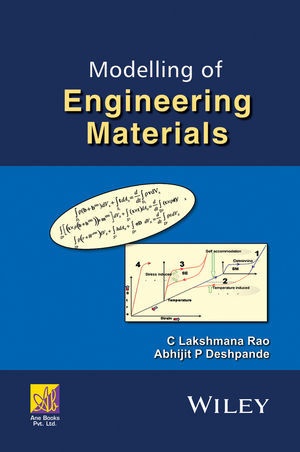Read more
Modelling of Engineering Materials presents the background that is necessary to understand the mathematical models that govern the mechanical response of engineering materials.
List of contents
Preface ix
Notations xiii
Chapter 1 : Introduction 1
1.1 Introduction to material modelling 1
1.2 Complexity of material response in engineering 2
1.3 Classification of modelling of material response 5
1.3.1 Empirical models 6
1.3.2 Micromechanical models 7
1.3.3 Phenomenological models 8
1.4 Limitations of the continuum hypothesis 9
1.5 Focus of this book 10
Chapter 2 : Preliminary Concepts 13
2.1 Introduction 13
2.2 Coordinate frame and system 13
2.3 Tensors 14
2.3.1 Tensors of different orders 15
2.3.2 Notations for tensors 17
2.4 Derivative operators 22
Summary 25
Exercise 25
Chapter 3 : Continuum Mechanics Concepts 29
3.1 Introduction 29
3.2 Kinematics 30
3.2.1 Transformations 34
3.2.1.1 Transformation of line elements 34
3.2.1.2 Transformation of volume elements 35
3.2.1.3 Transformation of area elements 36
3.2.2 Important types of motions 37
3.2.2.1 Isochoric deformations 38
3.2.2.2 Rigid body motion 39
3.2.2.3 Homogeneous deformations 40
3.2.3 Decomposition of deformation gradient 40
3.2.3.1 Polar decomposition theorem 40
3.2.3.2 Stretches 42
3.2.4 Strain measures 42
3.2.4.1 Displacements 43
3.2.4.2 Infinitismal strains 44
3.2.5 Motions 44
3.2.5.1 Velocity gradient 45
3.2.6 Relative deformation gradient 48
3.2.7 Time derivatives viewed from different coordinates 49
3.2.7.1 Co-rotational derivatives 50
3.2.7.2 Convected derivatives 52
3.3 Balance laws 55
3.3.1 Transport theorem 56
3.3.2 Balance of mass 57
3.3.3 Balance of linear momentum 58
3.3.4 Balance of angular momentum 62
3.3.5 Work energy identity 63
3.3.6 Thermodynamic principles 65
3.3.6.1 First law of thermodynamics 65
3.3.6.2 Second law of thermodynamics 67
3.3.6.3 Alternate energy measures in thermodynamics 68
3.3.7 Referential description of balance laws 70
3.3.7.1 Relations between variables in deformed and undeformed configurations 70
3.3.7.2 Statement of the balance laws in reference configuration 72
3.3.8 Indeterminate nature of the balance laws 73
3.3.9 A note on multiphase and multi-component materials 74
3.3.9.1 Chemical potential 75
3.4 Constitutive relations 75
3.4.1 Transformations 76
3.4.1.1 Euclidean transformations 76
3.4.1.2 Galilean transformations 77
3.4.2 Objectivity of mathematical quantities 77
3.4.3 Invariance of motions and balance equations 79
3.4.4 Invariance of constitutive relations 79
3.4.4.1 Frame invariance in a thermoelastic material 81
3.4.4.2 Constitutive relations for thermoelastic materials 82
3.4.4.3 Frame invariance and constitutive relations for a thermoviscous fluid 85
3.4.5 Frame invariance of derivatives 87
Summary 89
Exercise 90
Chapter 4 : Linear Mechanical Models of Material Deformation 95
4.1 Introduction 95
4.2 Linear elastic solid models 96
4.2.1 Small strain assumption of linear elasticity 98
4.2.2 Classes of elastic constants 98
4.2.2.1 General anisotropic linear elastic solid 99
4.2.2.2 Materials with single plane of elastic symmetry 100
4.2.2.3 Materials with two planes of elastic symmetry 100
About the author
C. Lakshmana Rao is a Professor in the Department of Applied Mechanics at Indina Institute of Technology (IIT) Madras, India. He obtained his B.Tech and MS from IIT Madras and Sc.D. from Massachusetts Institute of Technology. He teaches courses on continuum mechanics, numerical modeling, fracture mechanics and mechanics of materials. His research interests include modeling of failure in brittle materials, buckling control using smart materials and ballistic impact mechanics.
Abhijit P. Deshpande is a Professor in the Department of Chemical Engineering at IIT Madras, India. He obtained his B.Tech from IIT Bombay, M.S. from the University of Pittsburgh and Ph.D. from the University of Washington. He teaches courses on continuum mechanics, polymer rheology, momentum transfer and thermodynamics. His research interests include polymer rheology, flow visualization, ionically conducting polymers and polymeric composites.
Summary
Modelling of Engineering Materials presents the background that is necessary to understand the mathematical models that govern the mechanical response of engineering materials.

